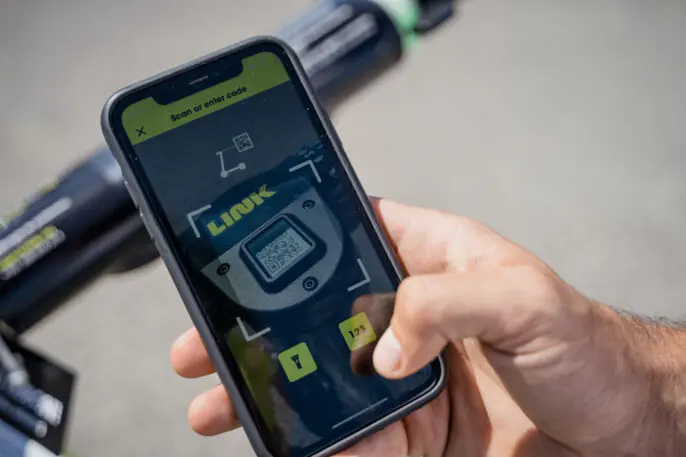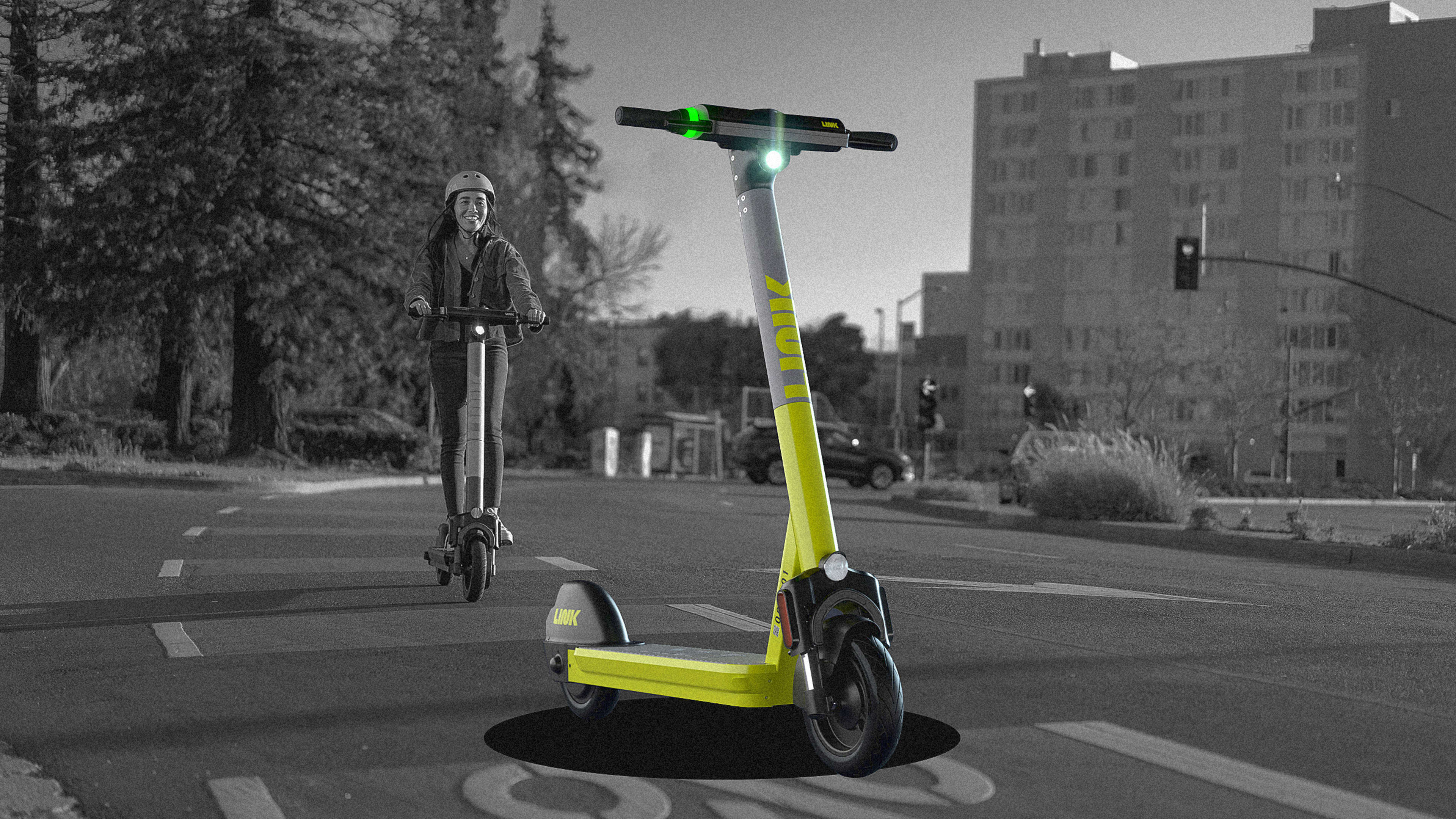When they began popping up on city streets in recent years, electric scooters were framed by their providers as a fun new shared transportation alternative. But their integration into city transportation systems has been less than smooth. They’re often left parked in inconvenient places. They’re sometimes ridden in unsafe manners on busy sidewalks or against traffic. And they’re connected to a concerning number of injuries, particularly for riders not wearing helmets and for pedestrians on sidewalks.
These unsafe and inconsiderate riding behaviors have given e-scooters and the companies that operate them a problematic reputation. One e-scooter company, Link, has decided to take direct aim at these downsides, launching a new system in its scooters that tracks rides, reprimands riders for unsafe behavior, and can even slow or stop a ride that’s deemed a high risk. “It’s an existential issue for the industry if we can’t demonstrate that we can do something about this,” says Paul White, senior director of public affairs at Superpedestrian, the MIT spin-off company that developed Link.
Tracking and taking control of e-scooters remotely while people are riding them may sound like valid safety measures, but to some they also sound like the overreaching powers of a central, autonomous system imposing its desires at will. Link and its parent company are well aware of the authoritarian leanings of this type of technology, but argue that actually taking control of vehicles will be rare, and will be backed up by abundantly clear evidence of unsafe riding.
“A lot of times people will say, ‘Why don’t we do these for cars instead?'” White says. “There are a lot of ways to answer that question, but I think a really insightful answer is that e-scooters are sharing space with other road users in really unique ways.” The ease of navigating e-scooters, whether they’re being ridden law-abidingly in a bike lane or swerving from a wrong-way street to a crowded sidewalk, is also a major safety challenge to solve.
Their solution is the Pedestrian Defense system, a precise, real-time tracking and remote control system that can detect and in some cases stop dangerous riding. Using patented data analysis and tracking technology, the system can identify unsafe riding behaviors like wrong-way riding, sidewalk riding, aggressive riding, swerving, and hard braking. Lights and audible sounds are activated during unsafe riding behavior, and customized alerts and safety advisories are sent through rider accounts and to phones via SMS. “Wrong-way riding is something that endangers riders and pedestrians alike,” White says. “If the behavior is dangerous enough, if it’s egregious enough, we will slow and stop the scooter.”

The Pedestrian Defense system is being added to Link’s scooters in the roughly 48 cities in North America and Europe where it operates through the recent acquisition of micromobility safety startup Navmatic, which developed the technology. Link has most recently been demonstrating the system for cities and transportation officials in California, as well as gathering feedback. But it’s also using the tech to help make the case for why Link should be given permits to operate on city streets. The safety element seems to be helping, with Link launching a 5,000-scooter fleet in Los Angeles last week, its largest to date, along with another 300 in Detroit. The company will begin integrating the Pedestrian Defense system in December, with the aim of having it operating on every one of its 25,000 scooters by the end of 2022.
White says the system was developed with safety as its priority, not only for riders but also for pedestrians, who are often most impacted by unsafe riding and inconsiderate scooter parking behavior.
But not all unsafe scooter riding is necessarily a sign of bad rider behavior. White says the system uses a large database of map and riding information to help understand when sidewalk riding or swerving is perhaps a late-night ride home from the bar, and when it’s a rider avoiding more dangerous paths on the street. “Sometimes this is just misbehavior and disrespect, but other times it’s a survival strategy,” he says.
In cities without clearly marked bike lanes or adequately lit roads, riding scooters in the streets as many states and cities require can be hazardous. “For the most part, we’re erring on the side of assuming that aberrant behavior is self-preserving behavior,” White says. Using data from the individual rider’s profile and riding history, and a larger set of data of previous rides in the same area, the company can determine when the behavior is becoming unsafe. “That’s when we start to alert the rider. And then if it’s really egregious or we’re seeing a repeated pattern, that’s when we would step in and censure the rider in some way, or control the rider in real time if it’s a sidewalk-riding event or wrong-way riding,” White says. Until the scooter is turned back in the correct direction, the rider will be unable to accelerate. For aggressive swerving, the rider will be given three light and sound warnings from the scooter before its speed is limited to 8 miles per hour.
[Image: Link]
Link is far from the only e-scooter company operating in cities. For riders who would rather not be scolded for unsafe riding, there’s little to prevent them from getting off a Link scooter and taking another company’s vehicle for a ride. Sam Morrissey is executive director of Urban Movement Labs, a public-private partnership developing mobility solutions in Los Angeles; he recently attended a demonstration of Link’s Pedestrian Defense system. He says the variety of e-scooters on the market could lead some unsafe riders to decide against the one that actively controls their riding, moving the problem from one type of scooter to another. “I think that’s a great fear, especially when you see on any corner in downtown Los Angeles there are three or four different manufacturers’ bikes or scooters available,” Morrissey says.
Link is less concerned with losing bad riders than with staying on the good side of the cities where it operates. It plans to use its new system to help those cities, freely sharing information on problem areas or recurrent safety issues in specific neighborhoods. “If a minority of scooter riders are swerving at a particular location, that might be more behavioral. But if a majority of scooter riders are swerving at that location, that’s an indication that there might be something going on that’s more structural or systemic that needs to be addressed,” White says. Though cities regularly collect data on street users like cars, bicycles, and pedestrians, the private nature of e-scooter companies means that much of the rich location and riding data is kept by the companies themselves—data they are sometimes resistant to share for privacy and business reasons.
Hilary Norton, executive director of FASTLinkDTLA, a Los Angeles-based organization focused on promoting programs that incentivize people to travel in modes other than alone in cars, also attended a recent demonstration of Link’s Pedestrian Safety system. She says this type of approach to safety and data sharing could give Link a leg up over competitors. “Cities are making decisions about who gets to operate,” says Norton, who also serves as chair of the California Transportation Commission. “The companies that have the right opportunities to show cities that they’re functioning well and keeping the rules of the road, I think they’re the ones that cities will want to continue to work with.”
Other scooter companies are seeing this dynamic as well. Spin, which is owned by the Ford Motor Co., announced in late 2020 that its e-scooters would be equipped with artificial intelligence technology to detect sidewalk riding and improper parking.
Morrissey says Link’s system represents the kind of proactive safety effort he’d like to see more companies take, especially when it comes to sending real-time feedback to riders, whether through lights and sounds or by physically slowing the vehicles.

“I would dream of a future like you see in the movie The Fifth Element, from the ’90s, where the dashboard of the guy’s car spits out tickets as he’s disobeying the law,” Morrissey says. “From a behavior change standpoint, if you’ve ever trained a dog, you know you need to be able to counter behavior immediately or people aren’t going to remember and it’s not going to have a real lasting effect on them.”
Link may be setting itself up to be the best nag in the scooter business—or perhaps the most authoritarian—but White says safety is the priority. With the data it collects from its riders and shares with city transportation officials, the company, he says, can help provide much needed information about how and where scooters are used, and where safety problems are most likely to occur. “With this data we can actually prevent crashes from happening in the first place,” he says. “That’s really what this is about.”
Recognize your brand’s excellence by applying to this year’s Brands That Matter Awards before the early-rate deadline, May 3.
